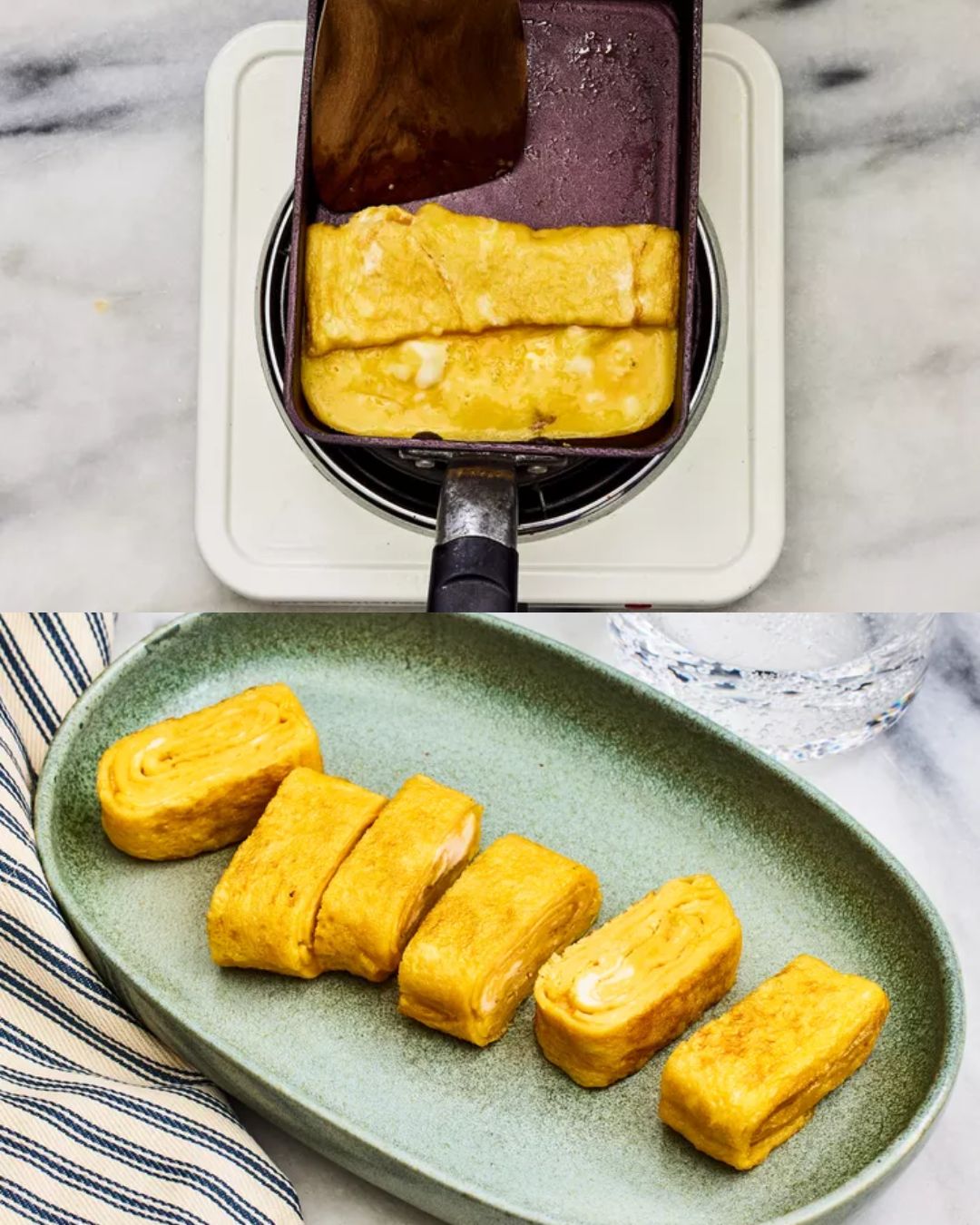Japanese Tamago, often referred to as Tamagoyaki or Atsuyaki Tamago, is a beloved and iconic dish in Japanese cuisine. It’s a sweet, savory omelette that is delicately rolled into layers and cooked to perfection. This dish is commonly served in Japanese bento boxes, at sushi restaurants, or as a simple breakfast or side dish. While the recipe may seem simple at first glance, the result is an incredibly flavorful and satisfying dish that is adored by people of all ages.
What makes Tamago truly timeless is its unique balance of sweet and savory flavors, which comes from the combination of soy sauce, mirin (a type of sweet rice wine), and a touch of sugar. These ingredients, when blended with the natural richness of eggs, create a harmonious taste that pairs beautifully with rice or stands alone as a snack. The process of cooking Tamago is almost like an art form, as it requires patience and precision to achieve the perfect layers and texture. Tamago is more than just an omelette—it’s a delicate culinary creation that reflects the precision and care embedded in Japanese cooking traditions.
Tamago’s popularity extends far beyond Japan, having captured the hearts of food lovers worldwide. Its simple, elegant presentation and versatile flavor make it the perfect addition to any meal, whether you’re serving it for breakfast, lunch, or as a topping for sushi. While it may look complex, this recipe proves that with the right ingredients and technique, anyone can master the art of making this delicious dish at home.
In this recipe, we will walk you through each step of making Tamago, from the preparation of the ingredients to the final plating. Whether you’re new to Japanese cooking or have been experimenting with Asian flavors for years, Tamago is a dish that is both accessible and endlessly rewarding.
Full Recipe:
Ingredients
For the Tamagoyaki:
- Eggs: 4 large
- Dashi Stock: 1/4 cup, prepared
- White Sugar: 1 tablespoon
- Mirin: 1 teaspoon (Japanese sweet rice wine)
- Soy Sauce: 1/2 teaspoon
- Vegetable Oil: 1/2 teaspoon, or more as needed
Prep Time, Cooking Time, and Total Time
- Prep Time: 10 minutes
- Cooking Time: 15 minutes
- Total Time: 25 minutes
- Servings: 2-4
Step-by-Step Instructions
Step 1: Prepare the Egg Mixture
- Crack the eggs into a mixing bowl and beat them gently with chopsticks or a fork until the yolks and whites are combined. Avoid over-beating, as you want to maintain some texture.
- Add the dashi stock, sugar, mirin, and soy sauce to the eggs. Mix well to ensure all ingredients are evenly incorporated.
Step 2: Heat the Tamagoyaki Pan
- Heat a rectangular tamagoyaki pan (or a small non-stick skillet) over medium heat. Add a small amount of vegetable oil and spread it evenly across the surface using a paper towel or brush.
- Ensure the pan is well-coated to prevent sticking, but do not leave excess oil in the pan.
Step 3: Cook the Layers
- Pour a thin layer of the egg mixture into the pan, just enough to cover the surface. Tilt the pan to spread the mixture evenly.
- Once the egg is almost set but still slightly wet on top, use chopsticks or a spatula to gently roll the egg from one side of the pan to the other. Push the rolled egg to one side of the pan.
Step 4: Add More Layers
- Re-grease the pan lightly with oil, and pour another thin layer of the egg mixture into the pan. Lift the rolled egg slightly to let the new mixture flow underneath it.
- Cook until the new layer is almost set, then roll the egg again, starting from the existing roll. Repeat this process until all the egg mixture is used, forming a thick, layered roll.
Step 5: Shape the Tamagoyaki
- Once the tamagoyaki is fully cooked, transfer it to a bamboo sushi mat (if available) or a cutting board.
- Wrap the tamagoyaki in the mat to shape it into a neat rectangular block. Let it rest for a few minutes to cool slightly and hold its shape.
Step 6: Slice and Serve
- Slice the tamagoyaki into even pieces, about 1-inch thick. Serve warm or at room temperature. It can be enjoyed on its own or accompanied by a dipping sauce like soy sauce or grated daikon.
Why This Recipe Is Timeless
Tamagoyaki is a dish that has stood the test of time for good reason. It captures the essence of Japanese cuisine, where simplicity meets sophistication. The harmonious blend of sweet, savory, and umami flavors makes it universally appealing, whether as part of a traditional Japanese breakfast, a sushi topping, or a bento box addition. Its delicate layers and smooth texture are a testament to the care and skill that go into preparing it.
In Japanese culture, tamagoyaki represents more than just a meal; it symbolizes thoughtfulness and artistry. It is often included in bento boxes as a token of love and care. The preparation of tamagoyaki, requiring patience and precision, reflects the value of mindfulness in Japanese cooking. Its enduring popularity across generations showcases its versatility and the deep appreciation for its unique taste and texture.
Nutrition Facts (Per Serving)
- Calories: 120 kcal
- Protein: 7 g
- Carbohydrates: 4 g
- Fat: 9 g
- Fiber: 0 g
- Sodium: 250 mg
FAQs
Q1: Do I need a special pan for tamagoyaki?
While a rectangular tamagoyaki pan is traditional and helps achieve the classic shape, a small non-stick round pan can also work. The taste and texture will remain the same, though the shape may differ.
Q2: Can I customize the flavor of tamagoyaki?
Absolutely! You can adjust the sweetness, add green onions or shredded nori for extra flavor, or experiment with other seasonings.
Q3: How do I prevent the tamagoyaki from sticking?
Ensure the pan is well-greased before each layer, and use a non-stick pan for best results.
Q4: Can tamagoyaki be made ahead of time?
Yes, tamagoyaki can be made a few hours ahead and stored at room temperature. It can also be refrigerated for up to 24 hours, though it is best enjoyed fresh.
Tips for Making the Perfect Tamagoyaki
- Maintain the right heat: Use medium-low heat to ensure the egg cooks gently and evenly without browning.
- Work quickly: Tamagoyaki requires a quick hand when rolling each layer to keep the texture smooth and tender.
- Use dashi stock: The umami-rich flavor of dashi is key to an authentic tamagoyaki. If unavailable, you can use water or a light chicken broth as a substitute.
- Practice patience: Rolling the egg takes practice, so don’t worry if your first few attempts aren’t perfect.
Storage Tips
- Room Temperature: Tamagoyaki can sit at room temperature for up to 4 hours.
- Refrigeration: Store leftover slices in an airtight container for up to 24 hours. Reheat gently in a pan or microwave.
- Freezing: Tamagoyaki is not ideal for freezing, as it may lose its delicate texture.
Conclusion
Japanese Tamagoyaki is much more than an omelette—it’s a work of art that embodies the essence of Japanese culinary tradition. The intricate layers, the balance of flavors, and the simplicity of ingredients all come together to create a dish that is both elegant and comforting. Tamagoyaki has remained a beloved recipe for generations because of its versatility, offering something special to every meal.
Whether you’re a seasoned cook or a beginner exploring Japanese cuisine, mastering tamagoyaki is a rewarding experience. Each roll you make improves with practice, turning a humble omelette into a dish of beauty and skill. This timeless classic is a reminder of the importance of patience, care, and tradition in the kitchen. Share this dish with your loved ones, and you’ll discover why tamagoyaki continues to captivate hearts and palates around the world.

